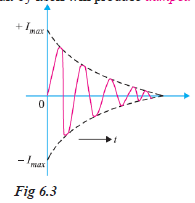- A circuit which produces electrical oscillations of any desired frequency is known as an oscillatory circuit or tank circuit.
- A simple oscillatory circuit consists of a capacitor (C) and inductance coil (L) in parallel as shown in Fig. 6.2. This electrical system can produce electrical oscillations of frequency determined by the values of L and C. To understand how this comes about, suppose the capacitor is charged from a d.c. source with a polarity as shown in Fig. 6.2 (i).
(i) In the position shown in Fig. 6.2 (i), the upper plate of capacitor has deficit of electrons and the lower plate has excess of electrons. Therefore, there is a voltage across the capacitor and the capacitor has electrostatic energy.

(ii) When switch S is closed as shown in Fig. 6.2 (ii), the capacitor will discharge through inductance and the electron flow will be in the direction indicated by the arrow. This current flow sets up magnetic field around the coil. Due to the inductive effect, the current builds up slowly towards a maximum value. The circuit current will be maximum when the capacitor is fully discharged. At this instant, electrostatic energy is zero but because electron motion is greatest (i.e. maximum current), the magnetic field energy around the coil is maximum. This is shown in Fig. 6.2 (ii). Obviously, the electrostatic energy across the capacitor is completely converted into magnetic field energy around the coil.
(iii)Once the capacitor is discharged, the magnetic field will begin to collapse and produce a counter e.m.f.
According to Lenz's law, the counter e.m.f. will keep the current flowing in the same direction. The result is that the capacitor is now charged with opposite polarity, making upper plate of capacitor negative and lower plate positive as shown in Fig. 6.2 (iii).
(iv) After the collapsing field has recharged the capacitor, the capacitor now begins to discharge; current now flowing in the opposite direction. Fig. 6.2 (iv) shows capacitor fully discharged and maximum current flowing.
- The sequence of charge and discharge results in alternating motion of electrons or an oscillating current. The energy is alternately stored in the electric field of the capacitor (C) and the magnetic field of the inductance coil (L). This interchange of energy between L and C is repeated over and again resulting in the production of oscillations.
-
Waveform: If there were no losses in the tank circuit to consume the energy, the interchange of energy between L and C would continue indefinitely. In a practical tank circuit, there are resistive and radiation losses in the coil and dielectric losses in the capacitor. During each cycle, a small part of the originally imparted energy is used up to overcome these losses. The result is that the amplitude of oscillating current decreases gradually and eventually it becomes zero when all the energy is consumed as losses. Therefore, the tank circuit by itself will produce damped oscillations as shown in Fig. 6.3.

-
Frequency of oscillations: The frequency of oscillations in the tank circuit is determined by the constants of the circuit viz L and C. The actual frequency of oscillations is the resonant frequency (or natural frequency) of the tank circuit given by:

- It is clear that frequency of oscillations in the tank circuit is inversely proportional to L and C.
This can be easily explained. If a large value of capacitor is used, it will take longer for the capacitor to charge fully and also longer to discharge. This will lengthen the period of oscillations in the tank circuit, or equivalently lower its frequency. With a large value of inductance, the opposition to change in current flow is greater and hence the time required to complete each cycle will be longer. Therefore, the greater the value of inductance, the longer is the period or the lower is the frequency of oscillations in the tank circuit.
Wilfykil answered the question on
August 15, 2019 at 09:07